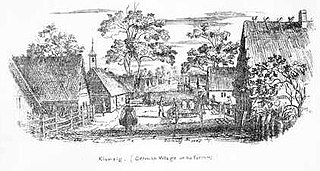Related Research Articles

Birdwood is a town near Adelaide, South Australia. It is located in the local government areas of the Adelaide Hills Council and the Mid Murray Council.

The Adelaide Hills region is located in the southern Mount Lofty Ranges east of the city of Adelaide in the state of South Australia. The largest town in the area, Mount Barker is one of Australia's fastest-growing towns. Before British colonisation of South Australia, the area was inhabited by the Peramangk people.

Hahndorf is a small town in the Adelaide Hills region of South Australia. Currently an important tourism spot, it has previously been a centre for farming and services.

Gotthard Daniel Fritzsche was a Prussian-Australian pastor who became instrumental in furthering that religion in South Australia. He was born in Liebenwerda, in the Electorate of Saxony, Germany, and migrated to Australia in 1841. From 1842–1863, he was pastor of the Evangelical Lutheran Church. He died and was buried at Lobethal, South Australia.

August Ludwig Christian Kavel was a founder of Lutheranism in Australia.
Gaza may refer to:

Lobethal is a town in the Adelaide Hills area of South Australia. It is located in the Adelaide Hills Council local government area, and is nestled on the banks of a creek between the hills and up the sides of the valley. It was once the centre of the Adelaide Hills wool processing industry, which continued until around 1950. The mill buildings are now used by a number of cottage industry and handcraft businesses. At the 2016 census, Lobethal had a population of 2,135.
The history of theLutheran Church of Australia is the sequence of events related to divisions, mergers and affiliations of Lutheran church organisations from the time Lutheranism first arrived in Australia, to the time of unification of the two main synods in 1966.

German settlement in Australia began in large numbers in 1838, with the arrival of immigrants from Prussia to Adelaide, in the then colony of South Australia. German immigrants became prominent in settling South Australia and Queensland. From 1850 until World War I, German settlers and their descendants comprised the largest non-British or Irish group of Europeans in Australia.
The Schützenfest held annually in Adelaide, the capital of South Australia, is a German cultural festival. Schützenfests are held in Germany and also around the world. The Adelaide festival has been reputed to be the second largest Schützenfest in the world.

Klemzig is a suburb of Adelaide in the City of Port Adelaide Enfield. It was the first settlement of German immigrants in Australia and was named after the village of Klemzig in what was then German Prussia and is now Klępsk in western Poland.

Verdun is a small town in the Adelaide Hills, Australia, on the road from Hahndorf to Balhannah. At the 2011 Australian Census the town recorded a population of 662.

Old Lutherans were originally German Lutherans in the Kingdom of Prussia, notably in the Province of Silesia, who refused to join the Prussian Union of churches in the 1830s and 1840s. Prussia's king Frederick William III was determined to unify the Protestant churches, to homogenize their liturgy, organization and even their architecture. In a series of proclamations over several years the Church of the Prussian Union was formed, bringing together the majority group of Lutherans, the minority of Reformed. The main effect was that the government of Prussia had full control over church affairs, with the king recognized as the leading bishop.

Traugott Wilhelm Boehm was a schoolmaster, founder of the German School in Hahndorf, South Australia, which became Hahndorf Academy then Hahndorf College.
The All-British League was an organisation in South Australia during World War I. Its objectives were to promote British traditions and culture at the expense of others in the state, especially to suppress any social or political influence from German Australian citizens and residents, whether born in Australia or not.
There have been a number of organisations known as the German Club in Adelaide, South Australia. The two most notable ones are:
The Hundred of Beatty, formerly the Hundred of Krichauff is a cadastral unit of hundred located in the Murraylands of South Australia spanning the localities of Beatty and Mount Mary.
The Hundred of Onkaparinga is a cadastral hundred of the County of Adelaide, South Australia, in the Adelaide Hills. It was proclaimed by Governor Frederick Robe in 1846 and named for the Onkaparinga River valley, which flows from north east to south west through the hundred.

County of Hanson is a cadastral unit located in the Australian state of South Australia that covers land in the Flinders Ranges immediately east of the town of Hawker. It was proclaimed on 20 July 1877 and is named after Sir Richard Davies Hanson who served as Premier, Administrator and Chief Justice of South Australia. It has been partially divided in the following sub-units of hundreds – Adams, Arkaba, French, Moralana and Warcowie.
References
- ↑ Nomenclature Act (No 2231 of 1935) (SA)
- ↑ Peake, A.H. (10 January 1918). "NOMENCLATURE ACT, 1917. Change of Place·Names" (PDF). The South Australian Government Gazette. Government of South Australia. 1918: 37 (PDF page 5). Retrieved 30 December 2018– via AustLII.
- ↑ State Records of South Australia, GRG 24/6, File 437/1935
- ↑ Leadbeater, Maureen M. "German Place Names, South Australia - World War I". B Leadbeater. Retrieved 20 April 2010.
- ↑ Manning, Geoffrey H. "South Australia - Nomenclature of South Australia". State Library of South Australia. Retrieved 20 April 2010.
- ↑ Harmstorf, Ian. "German History in South Australia". The German Club. Retrieved 20 April 2010.
- ↑ State Records of South Australia, GRG 24/6, File 437/1935